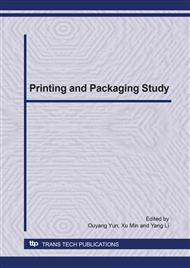p.366
p.370
p.374
p.381
p.385
p.389
p.393
p.397
p.401
Blending Property of Water-Based UV-Curable Polyurethane Acrylate and Epoxy Acrylate
Abstract:
Water-based UV-curable prepolymers are novel environmentally friendly materials. The blending property of two kinds of the prepolymers, water-based UV-curable polyurethane acrylate (UVPU) and water-based UV-curable epoxy acrylate (WEA), was studied in this paper. Blending compatibility, curing rate, optical and mechanical properties, and the cross-section morphology of the cured films of UVPU and WEA were investigated by Fourier transform infrared (FTIR), UV-visible spectrophotometer (UV-vis) and Environmental scanning electron microscopy (ESEM). Results indicated that the two prepolymers had good blending compatibility and high curing rate under UV radiation. The elongation at break of the cured film by WEA mixed with 20 wt% UVPU had 1.5 times increase compared to pure WEA, and the gloss increased 23% compared to pure UVPU, but the tensile strength decreased slightly. The morphology showed that the molecules of the two prepolymers polymerized each other and formed a network similar to the structure of Interpenetrating Polymer Networks (IPN). The comprehensive properties of the film were improved by blending of WEA and UVPU, and could be widely applied in the fields of coating varnish or printing ink.
Info:
Periodical:
Pages:
385-388
Citation:
Online since:
December 2010
Authors:
Price:
Сopyright:
© 2011 Trans Tech Publications Ltd. All Rights Reserved
Share:
Citation:


